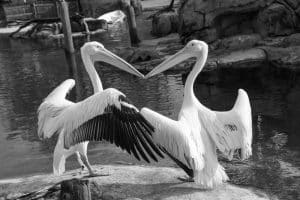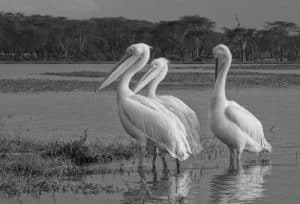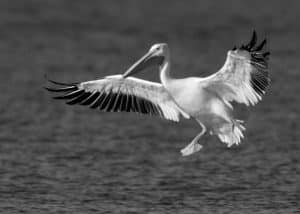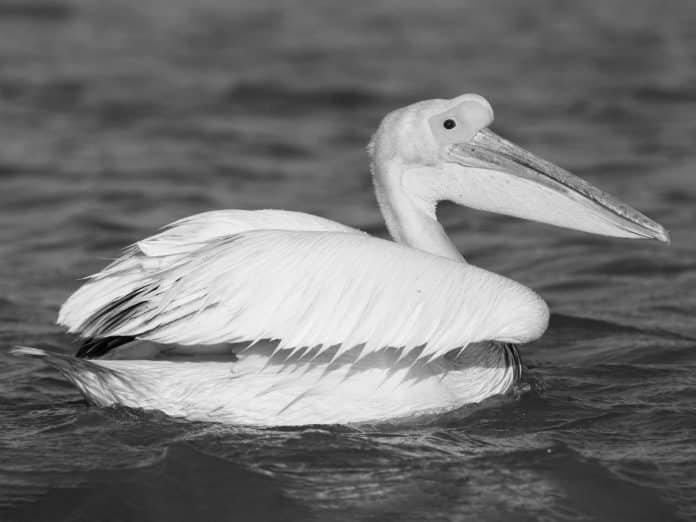Introduction to the Great White Pelican
Welcome to the land of the majestic Great White Pelican in Tanzania. The Great White Pelican, scientifically known as Pelecanus onocrotalus, is a sight to behold with its striking white plumage and graceful flight. Found in various parts of the world, including Tanzania, this magnificent bird has captured the fascination of bird enthusiasts and nature lovers alike. Standing at around 5 feet tall with a wingspan of up to 12 feet, the Great White Pelican is a truly impressive species. In this article, we will delve into the habitat, behavior, and conservation of these beautiful creatures in Tanzania, offering you a comprehensive guide to discovering the Great White Pelican in the heart of East Africa.
Habitat and Distribution of the Great White Pelican in Tanzania

The Great White Pelican is a widespread species, and Tanzania is fortunate to be one of the countries that host these magnificent birds. These pelicans are primarily found in freshwater lakes, marshes, and coastal lagoons, making Tanzania’s diverse landscape an ideal habitat for them. From the vast expanse of Lake Tanganyika to the tranquil waters of Lake Victoria, the Great White Pelican has made its presence known in various regions of Tanzania. The abundance of fish in these water bodies provides a plentiful food source for the pelicans, allowing them to thrive and form large colonies during the breeding season.
The distribution of the Great White Pelican in Tanzania extends beyond the lakes, reaching into the network of rivers that flow through the country. Rivers such as the Rufiji River and the Great Ruaha River serve as vital corridors for these birds, offering additional foraging grounds and nesting sites. The interconnectedness of the lakes and rivers in Tanzania plays a crucial role in sustaining the population of the Great White Pelican, making it essential to understand the significance of these waterways in the pelican’s life.
The Role of Lakes and Rivers in the Great White Pelican’s Life
Lakes and rivers are not just bodies of water to the Great White Pelican – they are lifelines that support the various stages of their life cycle. During the breeding season, the pelicans congregate on islands within the lakes, forming large, bustling colonies where they build their nests and rear their young. The calm, isolated nature of these islands provides a safe haven for the pelicans to carry out their nesting activities away from potential predators on the mainland.
In addition to serving as breeding grounds, the lakes and rivers of Tanzania are rich in fish, which form the primary diet of the Great White Pelican. These birds are highly skilled at cooperative fishing, using their large bills and expansive wings to corral and catch fish in unison. The abundance of fish in these water bodies ensures that the pelicans have access to a consistent food supply, allowing them to sustain their energy for migration and breeding.
The interconnectedness of lakes and rivers also plays a crucial role in the migratory patterns of the Great White Pelican. As the seasons change, the pelicans rely on these waterways to navigate their way to different feeding and breeding grounds. The ebb and flow of the rivers and the changing water levels of the lakes dictate the movements of these birds, highlighting the intricate relationship between the pelicans and their aquatic environment.
Navigating the Waterways: Great White Pelican’s Behavior
The behavior of the Great White Pelican is a captivating display of coordination, communication, and adaptability, all of which are finely tuned to their aquatic habitats in Tanzania. These birds are highly social and often engage in synchronized fishing, where they work together to herd fish into shallow waters before scooping them up with their pouch-like bills. Witnessing this spectacle of collective hunting is a testament to the pelicans’ ability to cooperate and thrive in their watery domain.
Aside from their remarkable fishing techniques, the Great White Pelican is also known for its graceful flight. With a wingspan that can exceed 12 feet, these birds are powerful and agile in the air, effortlessly gliding over the lakes and rivers of Tanzania. During the breeding season, their aerial displays and courtship rituals add an extra layer of enchantment to the already captivating scenery, making it a truly mesmerizing sight for onlookers.
The pelicans’ interaction with other species within their habitat further underscores their role in the ecosystem. From sharing fishing grounds with cormorants and herons to coexisting with various fish species, the Great White Pelican is an integral part of the intricate web of life in Tanzania’s waterways. Understanding their behavior and ecological connections is essential in appreciating the broader significance of these birds in their natural environment.
Conservation Efforts for the Great White Pelican in Tanzania

As with many species around the world, the Great White Pelican faces various conservation challenges, and Tanzania is actively involved in efforts to protect and preserve these birds. The degradation of wetlands, pollution, and human disturbance are among the primary threats to the pelicans’ habitat and well-being. To address these issues, conservation organizations, government agencies, and local communities have come together to implement measures aimed at safeguarding the Great White Pelican and its aquatic habitats.
One of the key initiatives involves the protection of critical nesting sites on the islands within the lakes. By designating these areas as protected zones and enforcing regulations to limit human interference, conservationists aim to provide undisturbed breeding grounds for the pelicans. Additionally, educational programs and community outreach efforts have been instrumental in raising awareness about the importance of coexisting harmoniously with these birds and the ecosystems they rely on.
Tanzania’s commitment to conservation extends beyond its borders through international collaborations and agreements aimed at safeguarding migratory routes and shared habitats of the Great White Pelican. By working in conjunction with neighboring countries and global conservation networks, Tanzania contributes to the broader conservation efforts that are essential for the long-term survival of these iconic birds.
Best Places to Spot the Great White Pelican in Tanzania
For those eager to witness the splendor of the Great White Pelican in Tanzania, there are several prime locations where these birds can be observed in their natural element. Lake Manyara, with its picturesque setting and diverse birdlife, offers an excellent opportunity to see the pelicans as they glide gracefully over the tranquil waters. The shallow alkaline waters of Lake Manyara provide an ideal foraging ground for the pelicans, making it a hotspot for birdwatchers and nature enthusiasts.
Another notable destination for spotting the Great White Pelican is Lake Natron, a unique saline lake nestled at the base of the Rift Valley. The otherworldly landscape of Lake Natron, coupled with the abundance of fish and nesting sites, makes it a captivating place to witness the pelicans in their breeding colonies. The surrounding area’s stark beauty and the pelicans’ synchronized flight patterns create a mesmerizing spectacle that is sure to leave a lasting impression.
Lake Victoria, the largest lake in Africa, is also a premier location for observing the Great White Pelican. Its vast expanse and diverse habitats harbor a wealth of bird species, including the pelicans, making it a must-visit destination for birdwatchers. The numerous islands and secluded bays of Lake Victoria provide ample opportunities to encounter these majestic birds as they go about their daily activities against the backdrop of the lake’s scenic beauty.
The Great White Pelican in Tanzanian Culture and History
The Great White Pelican holds a special place in Tanzanian culture and history, often featuring in local folklore, art, and traditions. In various indigenous communities, these birds are revered for their grace and beauty, with their presence symbolizing harmony and abundance. The pelicans’ prominent role in the local ecosystem has also led to their depiction in traditional stories and rituals, where they are celebrated as guardians of the lakes and rivers.
Furthermore, the historical significance of the Great White Pelican is intertwined with the exploration and documentation of Tanzania’s natural heritage. Early explorers and naturalists were captivated by the abundance of birdlife in Tanzania, including the striking presence of the Great White Pelican. Their accounts and illustrations have contributed to the enduring legacy of these birds, shaping the cultural narrative surrounding Tanzania’s avian diversity.
Photography Tips for Capturing the Great White Pelican
Capturing the elegance and grace of the Great White Pelican through photography requires a keen eye for detail and an understanding of the birds’ behavior. When photographing these birds in Tanzania, it’s essential to consider the lighting conditions, as the interplay of sunlight on the water can create stunning visual effects. Early morning and late afternoon are ideal times for photography, as the soft, golden light accentuates the pelicans’ features and creates a captivating ambiance.
Utilizing a telephoto lens can help in capturing close-up shots of the pelicans in flight or during their fishing activities, allowing for detailed compositions that highlight their intricate plumage and impressive wingspan. Patience is key when photographing wildlife, and observing the pelicans’ behavior can provide valuable insights into their movement patterns and interactions, enabling photographers to anticipate captivating moments and compositions.
In addition to focusing on the pelicans themselves, incorporating the surrounding landscape and water reflections can add depth and context to the photographs, showcasing the birds within their natural environment. Experimenting with different angles and perspectives can result in compelling images that convey the grandeur and serenity of the Great White Pelican against the backdrop of Tanzania’s lakes and rivers.
Birdwatching Tours and Expeditions for Great White Pelican Enthusiasts

Embarking on a birdwatching tour or expedition in Tanzania offers a unique opportunity to immerse yourself in the world of the Great White Pelican and other avian wonders. Guided tours led by experienced naturalists and birding experts provide valuable insights into the behavior, ecology, and conservation of these birds, enhancing the overall experience of encountering them in their natural habitats.
Many tour operators offer specialized birdwatching itineraries that encompass prime pelican-watching locations, ensuring that enthusiasts have the best chances of observing these birds in various settings. Whether it’s a leisurely boat trip on Lake Manyara, a guided hike along the shores of Lake Victoria, or a scenic flight over the Rift Valley, there are diverse ways to tailor your birdwatching experience to include the Great White Pelican and other spectacular species that call Tanzania home.
For those seeking a more in-depth exploration, multi-day expeditions that span different regions and ecosystems present an opportunity to witness the diversity of birdlife in Tanzania while focusing on the Great White Pelican as a centerpiece of the journey. These immersive experiences often include stays at eco-friendly lodges and camps, allowing participants to connect with nature and contribute to sustainable tourism practices that support the conservation of the pelicans and their habitats.
Conclusion
In conclusion, the Great White Pelican in Tanzania is a symbol of grace, resilience, and the interconnectedness of life within the country’s lakes and rivers. From their elegant presence in the cultural tapestry of Tanzania to their vital role in the ecological balance of the aquatic ecosystems, these birds embody the beauty and significance of avian diversity in East Africa. By understanding their habitat, behavior, and conservation status, we gain a deeper appreciation for the Great White Pelican and the need to safeguard their future.
As you embark on your journey to discover the Great White Pelican in Tanzania, may you find inspiration in the natural wonders that unfold along the lakes and rivers, and may your encounters with these majestic birds leave an indelible mark on your appreciation for the marvels of the avian world. Let us join hands in preserving the habitats and heritage that sustain the Great White Pelican, ensuring that future generations can continue to be captivated by their presence in the heart of Tanzania’s aquatic realms.

































